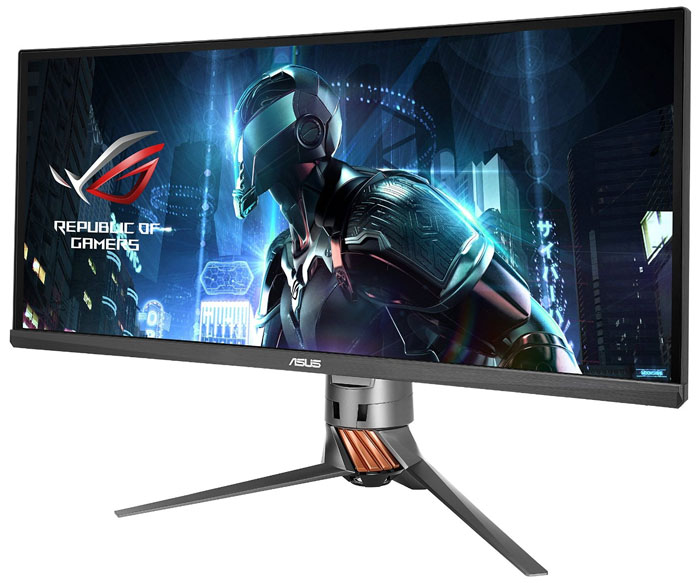Early Verdict
Curved ultra-wide monitors are still on the expensive side, but the sense of immersion they add to games, especially first-person shooters, is hard to get anywhere else. Now that there are more models with adaptive refresh like the PG348Q, players have several solid choices in displays to finish off their high-end rigs. We think the latest ROG Swift deserves serious consideration.
Pros
- +
Color accurate
- +
IPS panel
- +
Contrast
- +
Clarity
- +
100Hz refresh
- +
G-Sync
- +
Unique styling with LED effect
- +
Solid build
- +
Excellent stand
- +
OSD joystick
Cons
- -
Incorrect default contrast setting
Why you can trust Tom's Hardware
Introduction
We now believe that enough time has passed, and enough products have been introduced, that we can say curved ultra-wide monitors are not a passing fad. Although most of these monitors command high prices, gamers have embraced the enhanced sense of immersion and solid image quality.
There are two main categories of curved ultra-wide monitors. If you want the highest possible contrast and refresh rate, and are willing to accept 2560x1080 resolution, there are a couple of AMVA displays to consider. AOC’s C3583FQ and Acer’s Predator Z35 both run at super high speeds and easily exceed 2000:1 contrast. Plus they offer adaptive refresh and a tighter 2000R curvature.
At the high end of the resolution equation, we have several products with 3440x1440 pixels that offer either G-Sync or FreeSync as well as refresh rates from 75-100Hz. The monitor in our lab today fits into that second category. It’s the Asus ROG Swift PG348Q.
Specifications
The PG348Q offers up some high-end hardware with an AH-IPS panel made by LG Display. It also has the latest generation Nvidia G-Sync module that includes a convenient HDMI input. You’ll still need to connect to the DisplayPort for adaptive refresh and that 100Hz overclock however. HDMI supports 3440x1440 signals up to 50Hz.
Absent in this ROG monitor is any sort of backlight strobe/blur reduction feature. Other products in the line include ULMB with adjustable pulse width so you can strike a balance between motion resolution and brightness. It works as advertised, but you have to give up G-Sync in the process. In our view, that's only feasible when you can keep framerates solidly over 100fps. Since the PG348Q maxes at that level, ULMB doesn’t make much sense. Frankly, we’ve never used it on any of our previously-reviewed G-Sync screens, so no loss there.
The big feature is, of course, the curve and the ultra-wide 21:9 aspect ratio. We’re long past asking why these monitors exist when gamers are obviously into the concept. After playing on a variety of them, we are too. There’s nothing quite as immersive as an ultra-wide and even though it can’t substitute for three screens, the unbroken image is always compelling.
The PG348Q is a premium-priced product for sure, but does it deliver premium performance? Let’s take a look.
Get Tom's Hardware's best news and in-depth reviews, straight to your inbox.
Packaging, Physical Layout, And Accessories
The PG348Q’s carton is oversized and more than up to the task of protecting a large display. All the metal and polished bits are well-protected by either plastic wrap or foam sheets. The upright is already attached for you so all that needs doing is to bolt on the base. That’s accomplished with two wingnuts which are inserted in the sides where the legs attach. It’s a bit tricky but no tools are needed.
The power supply is a large external brick with some styling cues of its own in the form of polished Asus logos. You also get HDMI, DisplayPort and USB 3.0 cables. The manual and supporting software are bundled on a CD.
Product 360

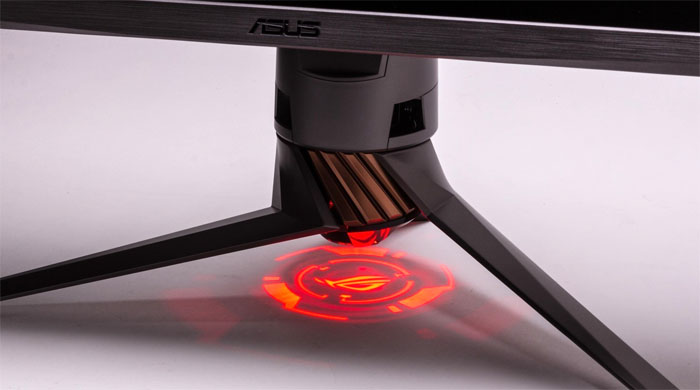
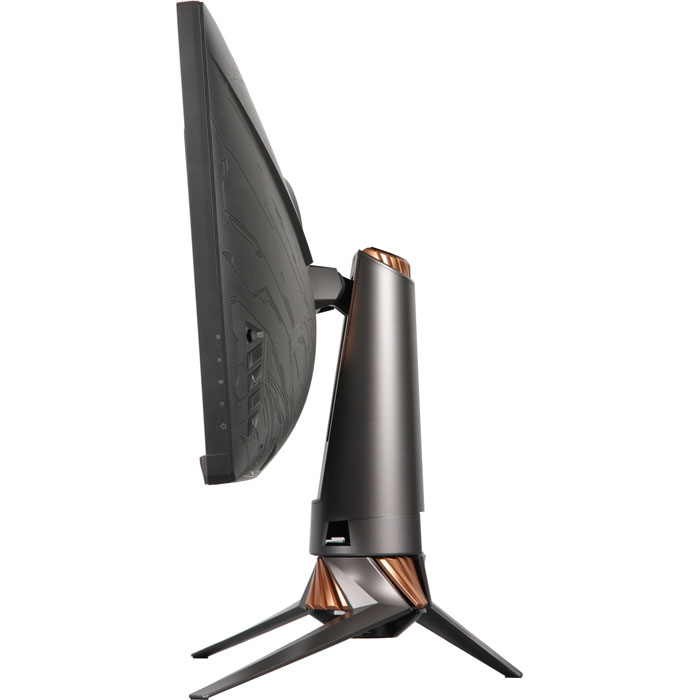
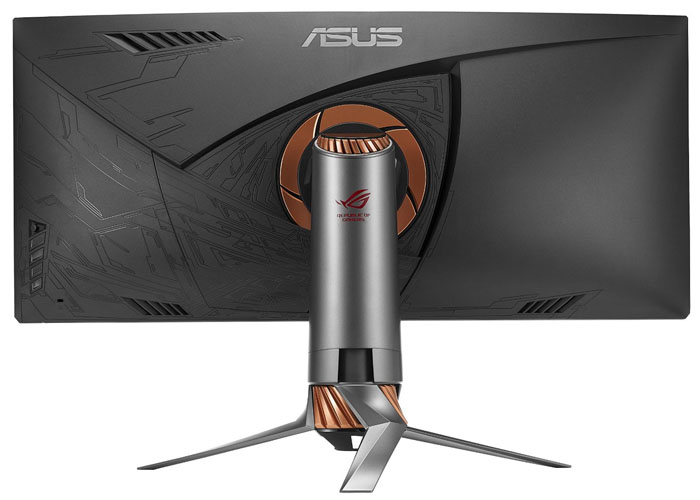
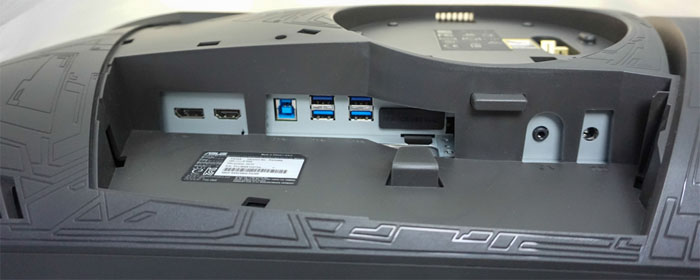
There is no attempt at subtle style here. The chassis looks like something you might find on the side of an Imperial Star Destroyer. The only straight lines are those that frame the screen. Every other surface has some sort of curve or taper. The panel is a dark gray while the base sports copper-colored accents. It reminds me a little of the windings seen in toroidal transformers.
From the front, the design appears bezel-free, but when the image is present, a thin border appears around it. The anti-glare layer is flush-mounted and extremely hard. Even when we pressed on it, the picture did not distort. Clarity is top-notch, and there is no sign of grain.
The controls are found by reaching around the back of the lower right corner, and consist of four buttons and a joystick. They operate with a strong click, and OSD navigation is quick and easy.
The base can emit a pattern of light that has three brightness settings in the OSD. It will move as you swivel the panel which also has tilt and height adjustments. It’s a neat effect but we’re surprised it only comes in red. The long legs are cast aluminum with a nice textured finish; very high-end.
The panel is nearly 3" thick thanks to the heavily-styled back piece. The spaceship theme is completely obvious here with molded in shapes and textures that suggest the hull of something traveling at warp speed. A small vent at the top and two speaker grills at the bottom are the only visible openings. The speakers sound decent, although they are not very loud. Frequency response is firmly in the mid-range and reasonably well-balanced. Thanks to the external power supply, heat is not a problem. The upright can be removed to reveal a 100mm VESA mount.
The input panel is difficult to reach and cables must be plugged in by feel. It’s recessed quite a bit, but after some fiddling we were able to make our HDMI and DisplayPort connections. There is one of each input along with USB 3.0 upstream (one) and downstream (four) ports. You also get a headphone output. To help tidy up your cable bundle, Asus provides a snap-on panel cover.
MORE: Best Computer Monitors
MORE: How To Choose A Monitor
MORE: Display Calibration 101
MORE: The Science Behind Tuning Your Monitor
MORE: All Monitor Content

Christian Eberle is a Contributing Editor for Tom's Hardware US. He's a veteran reviewer of A/V equipment, specializing in monitors. Christian began his obsession with tech when he built his first PC in 1991, a 286 running DOS 3.0 at a blazing 12MHz. In 2006, he undertook training from the Imaging Science Foundation in video calibration and testing and thus started a passion for precise imaging that persists to this day. He is also a professional musician with a degree from the New England Conservatory as a classical bassoonist which he used to good effect as a performer with the West Point Army Band from 1987 to 2013. He enjoys watching movies and listening to high-end audio in his custom-built home theater and can be seen riding trails near his home on a race-ready ICE VTX recumbent trike. Christian enjoys the endless summer in Florida where he lives with his wife and Chihuahua and plays with orchestras around the state.
-
RocketChild How's the cable management on this pretty monitor? Doesn't look like there is any and I take it no VESA mounting points either? Seems like a decent part of the cost with this monitor is that stand so you can have a flashlight on your surface. Good to see headway is being made with higher refresh rates at greater resolutions.Reply -
itsnotmeitsyou I don't understand why we're still seeing Predator/Bionicle themed high-end hardware... Can the kids that are into this garbage actually afford it?Reply
I would guess that the larger market is the people who grew up gaming that are now career professionals. I suppose that doesn't imply their taste in hardware styling has matured, but personally I'm over the whole PowerRangerMegaZord kitsch that started with Alienware in the 90s.
It looks like a beautifully specd monitor. Just wish it wasnt so painfully styled. -
moogleslam I've had this monitor since April 2016, and it's phenomenal. The combination of 21:9, 34", 3440x1440, 100Hz, Curved, IPS, & G-Sync cannot be bettered by anything currently on the market. Today, this is the ultimate gaming monitor. It's completely immersive, and I've had no issues with game support so far. Funnily, my most jaw dropping moment was when I first took it out of the box and saw the size of it.... before I even powered it up! It's huge! My own sample isn't 100% perfect though. There is noticeable IPS Glow/Backlight Bleed (I don't really know the difference) in all four corners, though it can only be seen in almost entirely black scenes, and fortunately, for the games I play, that's almost never. There are also visible scanlines at any overclock. You have to look very closely to see them, and certainly, during normal game play, I never notice them. In all though, I am incredibly happy with this monitor (even if I paid $1300!), and I expect it to serve me well for many years, regardless of what else comes to market!Reply -
Realist9 Wouldn't it be smarter to pick up a 4k of similar size/specs like the Predator XB32 for $60 more?Reply
Given you have the rig to run 4K?
My concern is relative adoption of 3440x1440 vs 4k. I *feel* like 3440 is not as widely supported as 4k, and with 4k, there's no fisheye (right?).
for ref: Currently running 3x32" surround on a 1080 (for ref concerning frame rate). 3440x1440 = 4.9M pix, 5760x1080 = 6.2M pix, and 4k = 8.3M pix. -
moogleslam Reply18663297 said:Wouldn't it be smarter to pick up a 4k of similar size/specs like the Predator XB32 for $60 more?
Given you have the rig to run 4K?
My concern is relative adoption of 3440x1440 vs 4k. I *feel* like 3440 is not as widely supported as 4k, and with 4k, there's no fisheye (right?).
for ref: Currently running 3x32" surround on a 1080 (for ref concerning frame rate). 3440x1440 = 4.9M pix, 5760x1080 = 6.2M pix, and 4k = 8.3M pix.
I've tried 4K, and this is far superior. There is no 4K with similar specs. Two of the three most important things this monitor provides are missing on 4K; 100Hz, and 21:9. Before this monitor, I had a 144Hz monitor, and dropping to 100Hz was a sacrifice I was willing to make, but I'll never go back to 60Hz, even with G-Sync/FreeSync. And 21:9 is the real difference maker. The extra horizontal screen real estate is amazingly useful, and it's what provides greater immersion than ever before; probably immersion that can only be beaten with VR (not even with triples because I hated the bezels).
I don't see any adoption issues. Firstly, this format is becoming more and more popular all the time. Secondly, whether it's adopted by the masses or not, I'v had zero support issues to date. The most I've had to do is edit a config file (World of Tanks), but all other games have been completely straight forwards.
There's zero fish eye in any games. I'm not quite sure what you're getting at.... I mean, your in-game FOV isn't distorted by having a wider monitor; you just see more left and right, in a completely natural manner; there's no stretching to fill it.
I've tried triples and 4K, and I firmly believe that the three most important factors in a gaming monitor, which I'll never go without again are:
21:9
G-Sync/FreeSync
100+Hz
Resolution would only be 4th on my list, and I'd even take a 2560x1080 21:9 before I went to 4K, just so I could have the 3 must haves above. -
moogleslam Reply18662798 said:How's the cable management on this pretty monitor? Doesn't look like there is any and I take it no VESA mounting points either? Seems like a decent part of the cost with this monitor is that stand so you can have a flashlight on your surface. Good to see headway is being made with higher refresh rates at greater resolutions.
Cable management is actually good. If I recall correctly, the cables, where they plug into the monitor, are hidden behind the back cover, and then feed through the stand, coming out at the rectangular square you can see at the bottom/back of it.
-
larsv8 This guy, or similar, is on my wish list for some time over the next two months. Heard the light bleed is really the only noticeable downside, but that is not the biggest deal.Reply
I am assuming this is mostly identical to the Predator X-34? Gonna have to make a decision on which brand to go with.
I am hoping the new version, the X34P, which is supposed to have some performance improvements is released soon, to either drive this price down, or be affordable enough to upgrade.
I can't wait to fire up Forza Horizon's 3 on this badboy at max settings. Good time to be a gamer!
-
moogleslam Reply18663459 said:This guy, or similar, is on my wish list for some time over the next two months. Heard the light bleed is really the only noticeable downside, but that is not the biggest deal.
I am assuming this is mostly identical to the Predator X-34? Gonna have to make a decision on which brand to go with.
I am hoping the new version, the X34P, which is supposed to have some performance improvements is released soon, to either drive this price down, or be affordable enough to upgrade.
I can't wait to fire up Forza Horizon's 3 on this badboy at max settings. Good time to be a gamer!
It uses the same panel as the Acer Predator X34, yes. The ASUS PG348Q seems to have had less issues/better QA, and the OSD and associated controls are far superior on the ASUS as well. Many also tend to prefer the PG348Q styling. Other than that, they're more or less identical.
Sim racing on these monitors, in cockpit view, is one of my favorite things. Try out iRacing if you can, and use the built in FOV calculator. -
infamousk12 This monitor is extremely expensive, however, it is absolutely amazing. I have owned it for about a month. Out of the box, it was easy to assemble and the quality of the parts is simply top notch. The monitor performs extremely well, and once you game on a native 21:9 aspect, you will never go back.Reply -
poochiepiano Reply
If you take a 4k monitor and chop of the top and bottom 1/6 of the screen, you get 1440p with an even wider screen. How is having additional vertical real estate bad? Assuming the 4k monitor has 100+ Hz that is variable, for the same price, I don't see how it's not better.18663372 said:I've tried 4K, and this is far superior. There is no 4K with similar specs. Two of the three most important things this monitor provides are missing on 4K; 100Hz, and 21:9. Before this monitor, I had a 144Hz monitor, and dropping to 100Hz was a sacrifice I was willing to make, but I'll never go back to 60Hz, even with G-Sync/FreeSync. And 21:9 is the real difference maker. The extra horizontal screen real estate is amazingly useful, and it's what provides greater immersion than ever before; probably immersion that can only be beaten with VR (not even with triples because I hated the bezels).
I've tried triples and 4K, and I firmly believe that the three most important factors in a gaming monitor, which I'll never go without again are:
21:9
G-Sync/FreeSync
100+Hz
Resolution would only be 4th on my list, and I'd even take a 2560x1080 21:9 before I went to 4K, just so I could have the 3 must haves above.
I love the 21:9 form factor too, and I use one at home, but at these prices, I don't see how a 1440 21:9 can beat a 4k with the same specs.
If the price was more in line with the comparative resolutions, aka it didn't cost virtually the same with <1/3 of the pixels, I would say that 1440p IPS in 21:9 with a 34" diagonal is my sweet spot too, but it just costs too much. This is pretty much the highest-end of these types of displays, especially with 100 Hz, so it's understandable, but with a comparable 4k? Why go with this?
